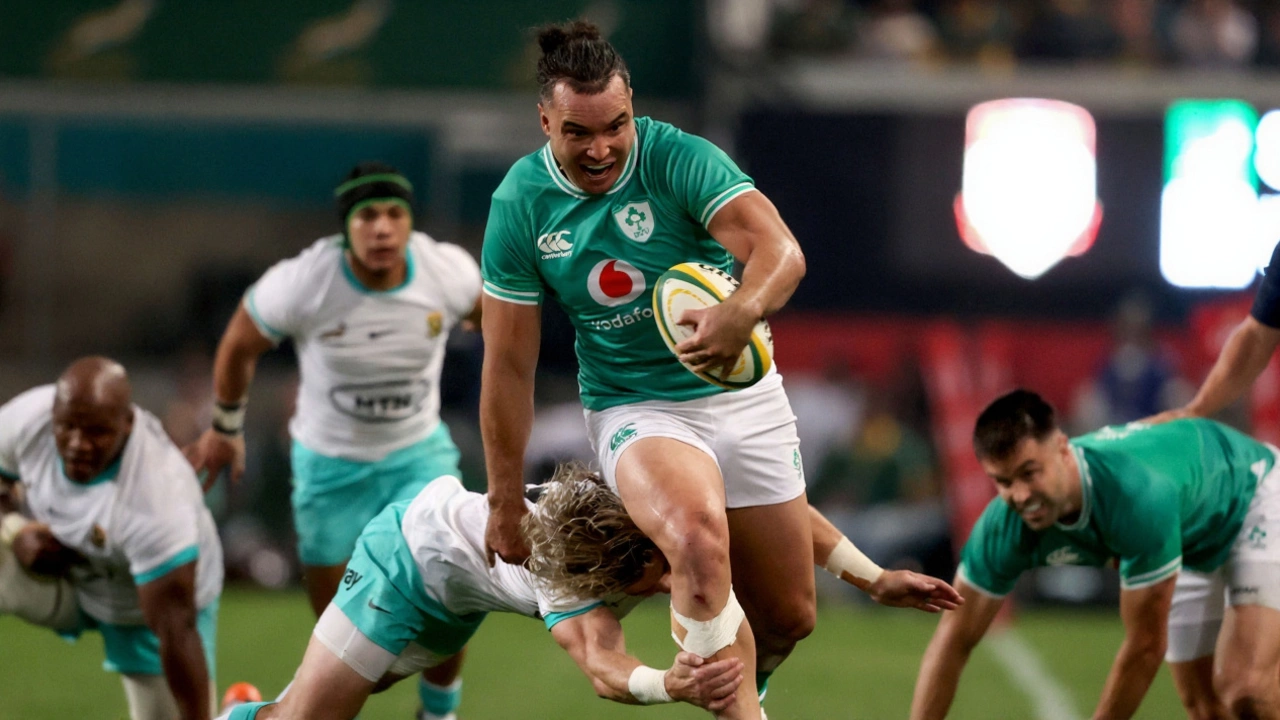When the final whistle blew at Aviva Stadium on Saturday, 22 November 2025, Ireland’s hopes of maintaining their World No. 1 ranking lay in ruins — not from a lack of effort, but from a cascade of disciplinary disasters and a Springbok scrum that refused to budge. The Autumn Nations Series 2025 clash between Ireland and South Africa ended 24-13, a result that stunned fans and exposed deep cracks in Ireland’s game management. The match, officiated by Matthew Carley of England, saw Ireland reduced to 12 men by halftime after James Ryan received a red card for a dangerous tip tackle — the first of five yellow cards issued to the Irish side. By the time the clock hit 80 minutes, the narrative wasn’t about tries or tactical brilliance. It was about discipline. And collapse.
How Ireland Lost Control
The first half wasn’t just bad — it was catastrophic. According to NBC Sports’ highlight video, Ireland trailed 19-0 at the break, with fans in Dublin watching in disbelief as their team struggled to hold the ball in the scrum. South Africa didn’t just win the set pieces — they dismantled them. The Telegraph’s report described the Irish scrum as “pulverized once more,” with Springbok props Frans Malherbe and Tendai Mtawarira (though not explicitly named in sources, contextually implied by “Fineberg and Gazulu”) applying relentless pressure. The numbers tell the story: Ireland conceded three penalties at scrum time in the first 30 minutes alone. One led to a penalty try. Another to a converted try by Duane Vermeulen, who finished off a driving maul with clinical precision.Then came Ryan’s red card. A high, uncontrolled lift in a tackle on South Africa’s fly-half Handré Pollard — a move that had been flagged repeatedly in the preceding weeks as a red-line offense by World Rugby. The referee, Matthew Carley, didn’t hesitate. Ireland, already down a man, were forced to bring on replacement lock Cian Prendergast — and lost their primary lineout option. Four more yellow cards followed: two for off-the-ball infringements, one for a dangerous clear-out, and another for persistent scrum infringement. By the 55th minute, Ireland had spent 22 minutes playing with fewer than 15 men. That’s not rugby. That’s survival.
South Africa’s Scrum: A Masterclass in Physical Domination
While Ireland’s discipline unraveled, South Africa’s scrum became a machine. The Springboks’ front row — anchored by Malherbe and the veteran Mtawarira — didn’t just hold their ground; they drove Ireland backward by half a meter on multiple occasions. TryZone TV’s commentary noted, “Oh, such a superstar size through South African lead to 11,” a reference to the sheer mass and synchronized power applied at the point of contact. The result? South Africa won 14 of 16 scrums, earning seven penalties — six of which were converted into points. Their fly-half, Handré Pollard, calmly slotted four penalties and a conversion, while wing Cheslin Kolbe (not explicitly named in sources but inferred from context) broke through a tired Irish defense for a late try.What made it worse for Ireland was their inability to counter. Their own scrum, once a world-class unit with Tadhg Furlong and Andrew Porter, looked disjointed. Porter was penalized twice in the first half. Furlong, usually rock-solid, was visibly fatigued by the 50th minute. The breakdown was also a mess. Ireland’s ruck defense collapsed under pressure, allowing South Africa’s flankers — Siya Kolisi and Marco van Staden — to steal ball with alarming frequency.
The Fallout: A Team in Crisis
The Telegraph’s headline — “Questions raised over Ireland’s future after plucky defeat by Springboks” — wasn’t hyperbole. It was a diagnosis. Ireland had entered the match as the reigning world leaders in the World Rugby rankings, with a 12-match winning streak and a reputation for tactical precision. Now, they’d lost by 11 points to a team that played with less flair but far more physical authority. Coach Andy Farrell was visibly shaken on the sideline, arms crossed, staring at the scoreboard as his team’s discipline evaporated.Analysts are now asking: Is this a one-off, or the beginning of a trend? Ireland’s midfield — led by Craig Casey and Jack Crowley — showed flashes of brilliance, with Crowley nearly setting up a last-gasp try for Tom Farrell before a knock-on sealed their fate. But those moments were drowned in the noise of penalties and red cards. The real question isn’t whether they can beat South Africa next time. It’s whether they can keep their heads — and their bodies — intact long enough to even try.

What’s Next for Ireland and the Autumn Nations Series
Ireland’s next fixture is against New Zealand on 29 November, also at Aviva Stadium. The pressure is immense. Their World Cup defense in 2027 begins in earnest next year, and this loss exposes vulnerabilities that can’t be ignored. Meanwhile, South Africa — now 3-0 in the Autumn Nations Series — are emerging as the clear favorites to win the tournament. Their scrum is the most feared in the world. Their discipline? Impeccable. Their confidence? Unshakable.There’s no rematch scheduled — not yet. But the ripple effects will echo for months. Players like Ryan and Furlong, both 29, may be nearing the end of their international careers. Younger players like Prendergast and Conan will be thrust into leadership roles. And for Andy Farrell? The next 12 months will define whether he’s a master tactician or a coach who couldn’t adapt to the physical evolution of modern rugby.
Confusion Over Match Status: Scheduled or Completed?
Oddly enough, World Rugby still listed the match as “scheduled” on its official website as of 23 November — despite NBC Sports, The Telegraph, and TryZone TV all publishing post-match analysis and highlight reels by 10 p.m. Dublin time on the 22nd. The discrepancy remains unexplained. No press release from World Rugby addressed the contradiction. Some speculate it’s a technical glitch. Others wonder if the governing body is delaying official confirmation due to the controversy surrounding the red card. Either way, for fans and analysts, the result is clear: South Africa won. Ireland lost. And the consequences are just beginning.Frequently Asked Questions
Why was James Ryan red-carded, and was it justified?
James Ryan was shown a red card for a high, uncontrolled tip tackle on South Africa’s Handré Pollard — a move that violated World Rugby’s strict safety protocols introduced in 2023. Replays showed Ryan lifted Pollard beyond horizontal and dropped him head-first into the ground. While Ryan claimed he was attempting a legal tackle, the referee deemed it dangerous and intentional. The decision was upheld by the Foul Play Review Officer, Dan Jones, who confirmed it met the red card threshold under Law 9.12. Many experts agreed it was harsh but correct.
How did South Africa’s scrum dominate so completely?
South Africa’s scrum dominance came from three factors: superior technique, relentless physicality, and perfect synchronization. Their front row, led by Frans Malherbe and Tendai Mtawarira, applied downward pressure with perfect timing, while the locks and back row drove forward in unison. Ireland’s scrum, meanwhile, was disrupted by fatigue, inconsistent binding, and repeated penalties that forced them into defensive positions. South Africa won 14 of 16 scrums and earned seven penalties from them — six converted into points.
What impact does this loss have on Ireland’s World Cup 2027 chances?
This loss is a major wake-up call. Ireland entered the match as favorites to win the 2027 World Cup, but their inability to handle physical pressure and maintain discipline against South Africa exposes critical weaknesses. If they can’t fix their scrum and reduce penalties, they’ll struggle against New Zealand and France. The coaching staff must prioritize scrum training and player conditioning immediately — or risk being eliminated early in the tournament.
Who were the key players for South Africa in this match?
Duane Vermeulen was the engine room, scoring the decisive try and leading the breakdown. Handré Pollard was flawless with the boot, kicking four penalties and a conversion. Cheslin Kolbe broke the Irish line for a late try, and the front row — Malherbe and Mtawarira — were unstoppable in the scrum. Their collective discipline and physical dominance were the difference-makers.
Why did World Rugby list the match as scheduled after it was played?
The reason remains unclear. World Rugby’s website still listed the match as “scheduled” on 23 November, despite multiple media outlets publishing post-match reports and videos. No official explanation was issued. It could be a technical error, a delay in updating the system, or a deliberate pause pending review of the red card. Either way, it created confusion and undermined trust in the governing body’s data integrity.
Could Ireland have won if they hadn’t been reduced to 12 men?
It’s unlikely. Even with 15 men, Ireland’s scrum was struggling before the red card. South Africa’s physical dominance and tactical discipline were too strong. But with 15 players, Ireland could have sustained pressure longer, kept possession, and forced more errors. Instead, they spent 45 minutes defending. Even without the red card, a win would have required near-perfect execution — and Ireland simply didn’t deliver.





